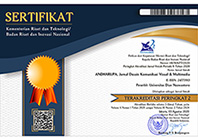RESPON WARGA TERHADAP PERUBAHAN VISUAL DAN PERWUJUDAN IDENTITAS PEMUKIMAN WONOSARI MENJADI KAMPUNG PELANGI SEMARANG
Abstract
Abstrak
Satu dasawarsa ini, fenomena mewarnai kampung kota (urban villages) telah menjadi salah strategi berbagai kota di pulau Jawa untuk menciptakan daya tarik wisata. Kampung kota yang seringkali terkesan kumuh, menjelma sebagai kawasan wisata dan menjadi ikon kota. Penelitian ini dilakukan di pemukiman Wonosari Gunung Brintik, Semarang dan saat ini dikenal sebagai Kampung Pelangi. Sejak 2017, warna-warni Kampung Pelangi tidak hanya berfungsi sebagai penanda visual suatu lokasi, tetapi telah mengubah fungsi pemukiman menjadi kawasan wisata. Penelitian ini berupaya untuk mengetahui perubahan yang terjadi khususnya setelah pemukiman Wonosari dikenal sebagai Kampung Pelangi dan menjadi ikon baru bagi Kota Semarang. Penelitian ini menggunakan metode campuran, tahap pendataan awal dilakukan melalui wawancara, kemudian dilanjutkan dengan penyebaran kuesioner untuk mengetahui respon warga setempat terhadap perubahan visual pemukiman Wonosari menjadi Kampung Pelangi. Penelitian bertujuan untuk memahami bagaimana Kampung Pelangi mewujudkan identitas tempat melalui citra lokal serta mencari pendekatan model pemberdayaan terhadap potensi lokal sehingga berdampak pada keberlanjutan Kampung Pelangi sebagai destinasi wisata.
Kata kunci: citra visual, identitas Kampung Pelangi, place branding
Abstract
For almost a decade, coloring urban villages have become one of the strategies of various cities in Java to create a tourist attraction. The urban villages, that often considered slum areas had transformed to be tourist destinations and become an icon of cities. This research conducted in the settlement of Wonosari Gunung Brintik, Semarang, or now known as Kampung Pelangi. Since 2017, the colorful Kampung Pelangi has not only visually transformed a location but has transformed into a tourist destination. This research uses a mixed-method, collection of data conducted through interviews and questionnaires. This study uses the perspective of place identity and focuses on the residents’ response to the visual changes of their settlement. This study also tries to understand the image construction process of place identity that represents its local values and search for an empowerment model that will impact the sustainability of Kampung Pelangi as a tourist destination.
Keywords: Kampung Pelangi’s identity, place branding, visual image
Full Text:
PDFReferences
Adiwibawa, B. A. P., & Prabowo, D. P. (2018). Karakter Fasad Bangunan Ikonik Kota sebagai Alternatif Desain Identitas Kota Semarang. ANDHARUPA: Jurnal Desain Komunikasi Visual & Multimedia, 2(01), 23–32.
Adler, P. S. (2009). The Oxford handbook of sociology and organization studies: Classical foundations. Oxford: Oxford University Press.
Altman,I. dan Low, S.M. (1992). Place attachment. New York: Plenum.
Arnheim, R. (1977). Visual thinking. Berkeley, Calif: University of California Press.Green,
A, Grace, D, Perkins, H (2016). City Branding Research and Practice: An Integrative Review. The Journal of Brand Management Volume 23, Issue 3, 252–272.
Hernandez, B. ; Hidlago, M.C. dan Ruiz, C., (2014). Theoretical and methodoligical aspects of research on place attachment. Place attachment: Advances in theory, methods and applications, 125-134.
Here?niak, M. (2017). Place Branding and Citizen Involvement: Participatory Approach to Building and Managing City Brands. Interdisciplinary Political and Cultural Journal Vol.19, No. 1.
Hornskov, S.B. (2007). On the management of authenticity: Culture in the place branding of Oresund. Place Branding and Public Diplomacy, 3(4), 317-331.
Jorgensen, B.s., dan Stedman, R.C. (2001) Sense of Place as an attitude: Lakeshore owners’ attitudes toward their properties. Journal of Environmental Psychology 21, 233-248.
Kaltenborn, B. P.( 1998). Effects of sense of place on responses to environmenta l impacts. A study among residents in Svalbard in the Norwegian high Arctic. Applied Geography 18 (2), 169–189.
Kavaratzis, M. (2004). From city marketing to city branding: Towards a theoretical framework for developing city brands. Place Branding. 1(1), 58-73.
Kavaratzis, M. (2015). Place branding scholars and practitioners: “Strangers in the night”? Journal of Place Management and Development 8(3): 266–270.
Kavaratzis, M., Warnaby, G., & Ashworth, G. J. (2015). Rethinking place branding: Comprehensive brand development for cities and regions.
Kotler et.all (2004). Where is place branding heading? Place Branding, Henry Stewart Publications 1, 12-35.
Lestari, W.M, dan J Sumabrata, J.(2018). The influencing factors on place attachment in neighborhood of Kampung Melayu. IOP Conf. Ser.: Earth Environ. Sci.
Manzo, L. C. dan Devine, W. P. (2014). Place attachment: Advances in theory, methods and applications.
Proshansky, H.M., Fabian, A.K. dan Kaminoff, R. (1983). Place Identity. Journal of Environmental Psychology, 3, 57-83.
Ram, Y.; Björk, P. dan Weidenfeld, A. (2016). Authenticity and Place Attachment of Major Visitor Attractions. Tourism Management, 52, 110-122.
Riza, M.; Doratli, N. dan Fasli, M. (2011). City Branding and Identity. In: Asia Pacific International Conference on Environment-Behaviour Studies, Salamis Bay Conti Resort Hotel, 7-9 December 2011. Eastern Mediterranean University, Famagusta, North Cyprus.
Sandström, S. (2007). Explaining the obvious : a theory of visual images as cognitive structures. Lund University.
Saraswati, D.R dan Nestri M.D. (2017). Kajian Estetika Lingkungan Kampung Pelangi Studi Kasus: Jalan Lingkungan Kampung Pelangi Gg. VI. In: Seminar Nasional Arsitektur Populis dan Tantangan Indonesia Masa Kini 2017. Semarang, Jawa Tengah Indonesia September 2017. Unika Soegijapranata: Semarang.
Skinner, H. (2008). The emergence and development of place marketing’s confused identity. Journal of Marketing Management, 24(9/10), 915-928.
Smaldone, D., Harris, C. dan Sanyal, N. (2008) The role of time in developing placce meanings. Journal of leisure resaerch, 40 (4), 479-504.
Stern, B.B. and Schroeder, J.E. (1994), “Interpretive methodology from art and literary criticism: a humanistic approach to advertising imagery”, European Journal of Marketing, Vol. 28 No. 8/9, pp. 114-32.
Stokols, D. dan Shumaker, S.A. (1981). People in places: A transactional view of settings. J. Harvey (ed.), Cognition, social behavio and the environment (p441-448). Hilsdale, NJ: Erlbaum.
Stubbs, J. and Warnaby, G. (2015). Rethinking place branding from a practice perspective: Working with stakeholders. dalam: M. Kavaratzis, G. Warnaby and G.J. Ashworth Rethinking Place Branding. Netherlands: Springer, pp. 101–118.
Tajfel, H. (1978). Differentiation between social groups: Studies in intergroup relations. London, England: Academic Press.
Vignoles, V.L. (2017) Identity: Personal and Social. Oxford handbook of positive psychology New York: Oxford University Press.
Zhang, L. Dan Zhao, S. (2009). City Branding and the Olympic Effect: A Case Study of Beijing. Cities 10.1016. 26. 245-254.
Sumber internet:
dictionary.com (2020) URL: https://www.dictionary.com/browse/branding [Diakses pada 17 Januari 2020]
businessdictionary.com (2020) URL: http://www.businessdictionary.com/definition/visual-identity.html [diakses pada 17 Januari 2020]
DOI: https://doi.org/10.33633/andharupa.v6i02.3473
Article Metrics
Abstract view : 744 timesPDF - 620 times
Refbacks
indexed by:
Andharupa Journal (p-ISSN: 2477 - 2852 | e-ISSN: 2477 - 3913) is published by Dian Nuswantoro University, Semarang. This Journal is licensed under Creative Commons Attribution 4.0 International License.
























